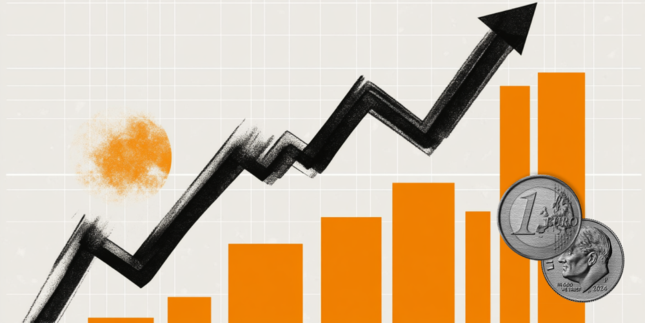- EUR/USD weakens to near 1.0965 in Monday’s early European session.
- The bullish outlook of the pair looks fragile on the daily chart, with the RSI indicator holding below the midline.
- The initial support level is seen at 1.0881; the immediate resistance level is located at 1.1000.
The EUR/USD pair trades in negative territory for the seventh consecutive day around 1.0965 during the early European session on Monday. The major pair remains under selling pressure amid the further upside in the US Dollar (USD). The recent US jobs data released on Friday has prompted traders to pull back expectations for 50 basis points (bps) Fed rate cut at the November meeting.
According to the daily chart, the bullish outlook of EUR/USD looks vulnerable as the major pair hovers around the key 100-day Exponential Moving Averages (EMA). EUR/USD could resume its downside bias if it decisively crosses below the 100-day EMA. Additionally, the downward momentum is supported by the Relative Strength Index (RSI), which stands below the midline near 37.55, suggesting that the path of least resistance is to the downside.
Decisive trading below the 100-day EMA at 1.0970 could see a drop to 1.0881, the low of August 8. The crucial support level for the pair emerges in the 1.0805-1.0800 zone, the low of July 9 and the round mark.
On the upside, the 1.1000 psychological level will be the first upside barrier for the pair. Extended gains could see a rally to 1.1144, the high of October 1. A break above this level could pave the way to 1.1223, the upper boundary of the Bollinger Band.
EUR/USD daily chart
Euro FAQs
The Euro is the currency for the 19 European Union countries that belong to the Eurozone. It is the second most heavily traded currency in the world behind the US Dollar. In 2022, it accounted for 31% of all foreign exchange transactions, with an average daily turnover of over $2.2 trillion a day. EUR/USD is the most heavily traded currency pair in the world, accounting for an estimated 30% off all transactions, followed by EUR/JPY (4%), EUR/GBP (3%) and EUR/AUD (2%).
The European Central Bank (ECB) in Frankfurt, Germany, is the reserve bank for the Eurozone. The ECB sets interest rates and manages monetary policy. The ECB’s primary mandate is to maintain price stability, which means either controlling inflation or stimulating growth. Its primary tool is the raising or lowering of interest rates. Relatively high interest rates – or the expectation of higher rates – will usually benefit the Euro and vice versa. The ECB Governing Council makes monetary policy decisions at meetings held eight times a year. Decisions are made by heads of the Eurozone national banks and six permanent members, including the President of the ECB, Christine Lagarde.
Eurozone inflation data, measured by the Harmonized Index of Consumer Prices (HICP), is an important econometric for the Euro. If inflation rises more than expected, especially if above the ECB’s 2% target, it obliges the ECB to raise interest rates to bring it back under control. Relatively high interest rates compared to its counterparts will usually benefit the Euro, as it makes the region more attractive as a place for global investors to park their money.
Data releases gauge the health of the economy and can impact on the Euro. Indicators such as GDP, Manufacturing and Services PMIs, employment, and consumer sentiment surveys can all influence the direction of the single currency. A strong economy is good for the Euro. Not only does it attract more foreign investment but it may encourage the ECB to put up interest rates, which will directly strengthen the Euro. Otherwise, if economic data is weak, the Euro is likely to fall. Economic data for the four largest economies in the euro area (Germany, France, Italy and Spain) are especially significant, as they account for 75% of the Eurozone’s economy.
Another significant data release for the Euro is the Trade Balance. This indicator measures the difference between what a country earns from its exports and what it spends on imports over a given period. If a country produces highly sought after exports then its currency will gain in value purely from the extra demand created from foreign buyers seeking to purchase these goods. Therefore, a positive net Trade Balance strengthens a currency and vice versa for a negative balance.
Information on these pages contains forward-looking statements that involve risks and uncertainties. Markets and instruments profiled on this page are for informational purposes only and should not in any way come across as a recommendation to buy or sell in these assets. You should do your own thorough research before making any investment decisions. FXStreet does not in any way guarantee that this information is free from mistakes, errors, or material misstatements. It also does not guarantee that this information is of a timely nature. Investing in Open Markets involves a great deal of risk, including the loss of all or a portion of your investment, as well as emotional distress. All risks, losses and costs associated with investing, including total loss of principal, are your responsibility. The views and opinions expressed in this article are those of the authors and do not necessarily reflect the official policy or position of FXStreet nor its advertisers. The author will not be held responsible for information that is found at the end of links posted on this page.
If not otherwise explicitly mentioned in the body of the article, at the time of writing, the author has no position in any stock mentioned in this article and no business relationship with any company mentioned. The author has not received compensation for writing this article, other than from FXStreet.
FXStreet and the author do not provide personalized recommendations. The author makes no representations as to the accuracy, completeness, or suitability of this information. FXStreet and the author will not be liable for any errors, omissions or any losses, injuries or damages arising from this information and its display or use. Errors and omissions excepted.
The author and FXStreet are not registered investment advisors and nothing in this article is intended to be investment advice.
Recommended content
Editors’ Picks

EUR/USD rises toward 1.1350 after finding support at near nine-day EMA
EUR/USD pauses its two-day decline, hovering near 1.1340 during Thursday’s Asian session. Daily chart technical analysis indicates a weakening bullish bias, as the pair has slipped below the ascending channel pattern.

GBP/USD: Bullish outlook remains in play above 1.3250
The GBP/USD pair drifts higher to around 1.3270, snapping the two-day losing streak during the early European trading hours on Thursday. Mitigating concerns over potential tariff threats by US President Donald Trump exerts some selling pressure on the US Dollar.

Gold price trims part of intraday gains, still well bid above $3,300 mark
Gold price regains positive traction as fading US-China trade optimism revives safe-haven demand. The US economic worries and Fed rate cut bets undermine the USD, also benefiting the commodity. A positive risk tone might hold back the XAU/USD bulls from placing aggressive bets and cap gains.

SEC Crypto Task Force plans to establish digital asset regulatory sandbox
The Securities & Exchange Commission's Crypto Task Force met with El Salvador's National Commission on Digital Assets representatives to discuss cross-border regulation and a proposed cross-border sandbox project.

Five fundamentals for the week: Traders confront the trade war, important surveys, key Fed speech Premium
Will the US strike a trade deal with Japan? That would be positive progress. However, recent developments are not that positive, and there's only one certainty: headlines will dominate markets. Fresh US economic data is also of interest.

The Best brokers to trade EUR/USD
SPONSORED Discover the top brokers for trading EUR/USD in 2025. Our list features brokers with competitive spreads, fast execution, and powerful platforms. Whether you're a beginner or an expert, find the right partner to navigate the dynamic Forex market.




